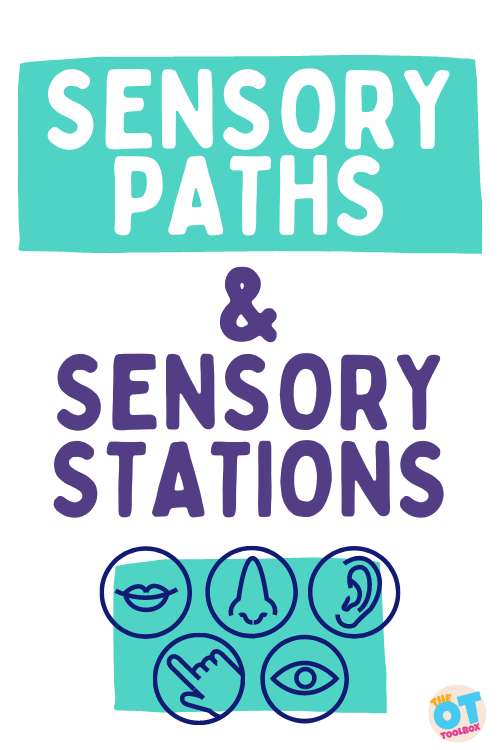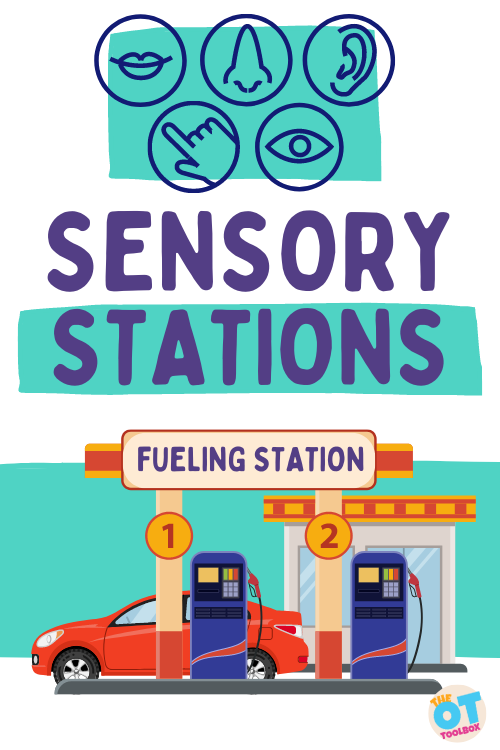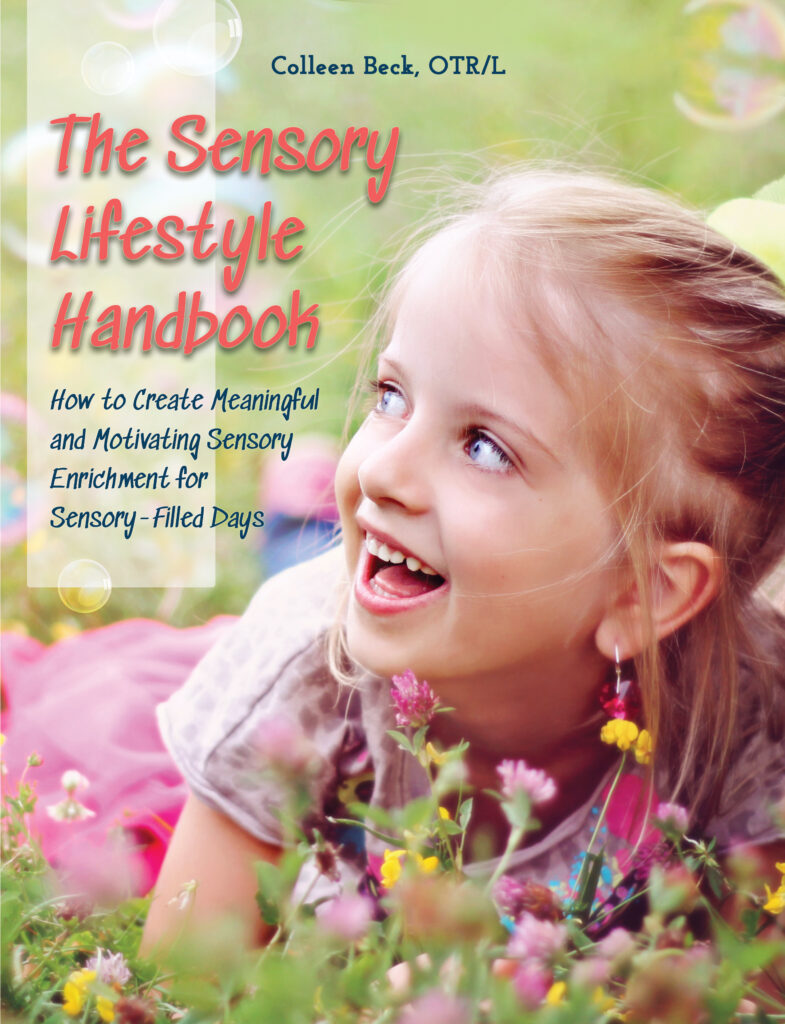A sensory walk, sensory station, and sensory path…what are these things and how do they support sensory processing needs? Here, we’re covering it all when it comes to using sensory paths or walks as a tool to support sensory needs. You’ll love the printable sensory station tools to add to your DIY sensory path!

What are Sensory Paths?
Let’s start with covering these terms.
A sensory path is a defined path, or walkway that directs users to complete a variety of sensory-motor tasks. The activities that make up a sensory path are typically gross motor tasks that incorporate proprioceptive input, vestibular input, and visual input. These sensory systems are powerful regulating tools to organize and this is why motor movements in a sensory path engage these systems.
A sensory path is typically a literal pathway on the ground; it may be painted onto a sidewalk or schoolyard. It may be stickers or images stuck to a floor or hallway in a school.
I know you’ve seen, or read about the (Amazon affiliate link) sensory pathways displayed on walls and floors of the school building. These are available commercially, or sensory paths can be made with paint and stickers.
Sensory paths can support self-regulation needs during transitions for children or scheduled sensory diets within a day.
What is a sensory walk?
A sensory walk is another term for a sensory path, however, some sensory walks can be nature-based, in the outdoors. Including flowers, grass, benches, and sounds of nature, a sensory walk can be very calming and regulating.
Other sensory walks are not nature-based. They are manufactured and can be also called sensory paths. Not only are the commercial versions of sensory paths expensive, but they are also highly colorful, and have multiple visual elements. These designs make for high visual noise (or visual clutter), making them ineffective for some children.
Some pathways can be highly dysregulating, as children attempt to decipher the visual clutter, and act on the path elements.

What are sensory stations?
Sensory stations are an area set up with the intention of engaging children in exercises that help to stimulate and regulate their senses, and facilitate transitions within the day. When children need a brain break, or if you need some fun ideas to meet sensory strategy goals, these are the perfect tool.
Sensory motor stations provide a visual, coupled with a written directive, that can be followed by most anyone who needs to build their sensory strategy bank.
Sensory stations can be part of a calm down corner or they can be posted in a hallway as a transition tool. These can be a specific area or “station” that allows users to pause and participate in self-regulation strategies: heavy work, vestibular movement, or deep breathing exercises, or mindfulness techniques.
Below, we have free printable sensory stations that you can use in a sensory path, sensory walk, or sensory corner. Are you interested in some freebies that are effective and fun? You’re in the right place visiting this post. It‘s full of Sensory Stations that you can print and post to make a fresh approach to self-regulation, use in creating a sensory path of your own.
If you work with children who need less stimulation, and more simplified visual directions, these FREE sensory stations are a must. They are simple, providing both visual and written directives. Download the PDF and go.
sensory stations in the school setting
In the school setting, sensory station printables can be used for an entire classroom, a small group, or with individual children. A sensory path is often sought out for use in the school setting, but once that sensory walkway is set on the asphalt, hallway linoleum, or in a certain space, it’s there for good!
Using a sensory station that can be removed and replaced with different themes is nice in the school setting because they can be used over and over again in different locations.
The nice thing about using a sensory station over a sensory path is that they can be posted throughout the school setting:
- Classrooms
- Therapy room
- Gymnasium
- School hallways
- Cafeteria
- Library
- Social worker’s office
- Guidance counselor’s office
- ESL classroom
- Or in different locations, to help children rotate through the stations throughout the day or as a brain break.
They offer the movement breaks students need, when and where they need them, to gain the sensory benefits they crave.
Print the sensory walk stations and provide a simple training to your school staff, to make these activities available for any child who needs the support.
sensory stations in a clinic
In a private clinic, sensory walk stations can be used in a pathway to different areas of the building, or posted in different locations where specific needs are being addressed.
In our private clinic, we have them posted on the wall down the hallway that leads to the therapy gym. These visuals serve as a great transitional tool, that helps children get ready for a different therapeutic environment.
Sensory walks can be provided as a home program, so they can be used as part of a child’s sensory diet. Some parents can’t afford sensory equipment like a swing or trampoline, so whenever possible, offer strategies they can afford.
Parents will be grateful for structured home exercises that are fun and motivating for their child.
Teletherapy sensory stations
Since the pandemic, therapists are often providing services through teletherapy occupational therapy. Sensory walk stations can be used as a warm-up, or sensory input activity for kiddos who need that support while having an on-line session.
They can easily be printed and displayed to the child over the computer, or do a screen share using the resource PDF. These printables are versatile. Changing them for different seasons or holidays, keeps them new and motivating.
what kind of sensory station ideas are available?
What kind of sensory station ideas can you find on the OT Toolbox? Seasonal and holiday-themed stations are available, with being added.
Grab these sensory path printables below, print, laminate, or slide them into a sheet protector, and hang them up today!
If you are a regular visitor to the OT Toolbox, you would benefit from our members club. Never miss a post, product, or freebie! Here are all the details:
Want to add this resource to your therapy toolbox so you can help kids thrive? Enter your email into the form below to access this printable tool.
This resource is just one of the many tools available in The OT Toolbox Member’s Club. Each month, members get instant access to downloadable activities, handouts, worksheets, and printable tools to support development. Members can log into their dashboard and access all of our free downloads in one place. Plus, you’ll find exclusive materials and premium level materials.
Level 1 members gain instant access to all of the downloads available on the site, without enter your email each time PLUS exclusive new resources each month.
Level 2 members get access to all of our downloads, exclusive new resources each month, PLUS additional, premium content each month: therapy kits, screening tools, games, therapy packets, and much more. AND, level 2 members get ad-free content across the entire OT Toolbox website.
Join the Member’s Club today!
Let’s take a look at what exactly you will find on the site today:
- Frog hop walk
- Spring flowers figure 8 deep breathing trace
- Flower wall push-ups
- Butterfly wings windmills
- Bumblebee trace and breathe
- Dolphin leap
- Bumblebees figure 8 deep breathing trace
- Beach ball press wall push-ups
- Crab squat summer sand squats
- Hermit crab shell trace and breathe
- Squirrel leaps
- Fall leaves figure 8 deep breathing trace
- Leaves wall push-ups
- Fall jumping jacks
- Acorn trace and breathe
- Penguin waddle
- Frosty wind and snow figure 8 deep breathing trace
- Snowball hands wall push-ups
- Ice skater one leg standing balance
- Snowflake trace and breathe
Christmas Sensory Walk Stations:
- Reindeer leap
- Christmas lights figure 8 deep breathing trace
- Santa sleigh push wall push-ups
- Jingle bell jumping jacks
- Christmas tree trace and breathe
If you are new to sensory processing difficulties, the Sensory Lifestyle Handbook is a great place to start.
The Sensory Lifestyle Handbook walks you through sensory processing information, each step of creating a meaningful and motivating sensory diet, that is guided by the individual’s personal interests and preferences.
The Sensory Lifestyle Handbook is not just about creating a sensory diet to meet sensory processing needs. This handbook is your key to creating an active and thriving lifestyle based on a deep understanding of sensory processing.
One last thing to point out about these sensory walk stations, is that they not only provide the sensory input a child may need, but they also address core strength, motor planning, crossing midline, eye-hand coordination, and overall, fine and gross motor skills.

Regina Parsons-Allen is a school-based certified occupational therapy assistant. She has a pediatrics practice area of emphasis from the NBCOT. She graduated from the OTA program at Caldwell Community College and Technical Institute in Hudson, North Carolina with an A.A.S degree in occupational therapy assistant. She has been practicing occupational therapy in the same school district for 20 years. She loves her children, husband, OT, working with children and teaching Sunday school. She is passionate about engaging, empowering, and enabling children to reach their maximum potential in ALL of their occupations as well assuring them that God loves them!



